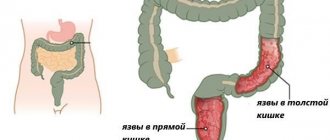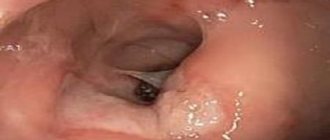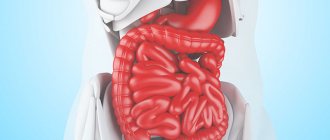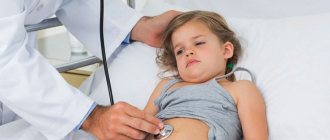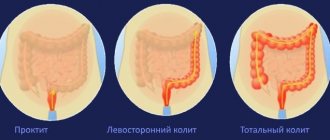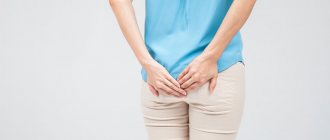A person often experiences rectal prolapse, which is associated with various reasons. When the rectum prolapses, the anatomical position is disrupted, as a result of which the organ is displaced beyond the sphincter of the posterior canal. Rectal prolapse is painful, and the person is unable to hold in stool. When going to the toilet, the patient experiences blood and mucus, and often feels a false urge to defecate.
Rectal prolapse can occur due to a number of external factors, diseases, and anatomical features in people of different ages.
Varieties
In medicine, rectal inversion is usually divided into 2 types:
- Intussusception. The displacement of the rectum occurs exclusively within the anus and the organ does not fall out of the anus.
- Hernia. The anterior wall of the rectum moves downward, which is associated with increased intra-abdominal pressure. In this case, partial or complete prolapse of the intestine from the posterior opening is observed.
Sometimes patients themselves try to straighten the rectum, which absolutely cannot be done. Such manipulations are dangerous and during defecation the intestine will fall back out.
Main reasons
All sources of rectal prolapse are divided into 2 groups: producing and presuming. Presumable causes include those that indirectly affect the development of prolapse. In this case, the problem develops with the following violations:
Surgeries, frequent exercise, constipation, ulcers can cause rectal prolapse
- after intestinal surgery;
- as a result of severe straining due to chronic constipation;
- after childbirth, which occurred with complications and caused damage to the muscles localized in the pelvic floor;
- injury to the sacral area of the spinal column;
- intestinal ulcer;
- haemorrhoids;
- grueling physical work requiring constant tension of the abdominal muscles.
Predisposing sources influencing prolapse of the rectal mucosa from the anus include:
- impaired function of muscle structures located in the pelvis;
- rectal muscle strain;
- increased pressure inside the peritoneum;
- weakened sphincter muscle tone;
- elongated rectum;
- difficult pregnancy;
- the anatomical location of the coccyx is vertical.
Briefly about the rectum
In fact, it is not entirely straight; it has two bends - perineal and sacral.
There are also three departments:
- anal;
- the widest and longest section is the ampullary;
- supramullary.
The organ wall is represented by three layers:
- mucous membrane, covering the inside and having goblet cells that produce protective mucus;
- muscular, consisting of longitudinal and circular fibers, especially developed in the area of the external and internal sphincters - muscle formations capable of holding feces;
- submucosal, in which single lymphatic follicles are located - accumulations of lymphoid tissue.
A serous membrane is also present for a short distance. The length of the organ can reach 18 centimeters. The main functions are retention and excretion of feces.
With various diseases, for example, rectal prolapse, the strength of the rectal sphincters decreases by approximately 4 times.
In women, in front of the rectum, the lining of the abdominal cavity (peritoneum) forms a pocket, bounded by the uterus and the posterior wall of the vagina, on the sides of which there are quite strong rectal-uterine muscles, which further strengthen the position of the rectum and prevent it from prolapse.
With rectal prolapse, the process involves all layers of the rectum and, less commonly, part of the sigmoid colon.
Degrees of pathology
| Stage | Name | Peculiarities |
| 1 | Compensated | The mucous membrane protrudes slightly out of the anal canal |
| Self-recovery after bowel movements | ||
| 2 | Subcompromised | Minor loss and slow recovery back |
| Pain in the anus and blood in the stool | ||
| 3 | Decompensated | Loss during bowel movements, sex and slight straining |
| The intestinal mucosa does not return to its original position | ||
| Significant bleeding from the anus | ||
| Incontinence of feces and gases | ||
| 4 | Deep decompensated | Constant loss without previous loads |
| Damage to the rectal mucosa | ||
| The occurrence of tissue necrosis with increased itching sensations |
Classification
Two forms of rectal prolapse are considered: hernial and invaginal. Type 1 prolapse is a consequence of weakening of the pelvic floor muscles with a simultaneous increase in intraperitoneal pressure.
Invagination prolapse is an internal displacement of the intestine without prolapse from the anus.
The stages of the disease according to mechanical and clinical characteristics are as follows:
- In the first stage (compensated), there is inversion of a small section of the intestine during the process of bowel movement, after which it returns to its normal position painlessly.
- In the second (subcompensated) process, the prolapse process proceeds similarly, but the return of the organ to its place is associated with the appearance of painful sensations and mucous or bloody discharge. Prolapse occurs not only during bowel movements, but also in the presence of physical stress.
- In the third case (decompensated, or tense), the intestine does not reduce on its own; it becomes necessary to reduce it by hand. Manifestations occur more often, bleeding increases. Symptoms of gas and fecal incontinence occur.
- The fourth stage is decompensated, permanent. This degree makes itself felt already in a state of relative peace.
The fourth stage is accompanied by necrotic processes on inflamed intestinal fragments. This provokes increased pain, the appearance of bloody and mucous discharge.
Characteristic symptoms
Rectal prolapse will cause frequent urge to go to the toilet, pain, bloating, and a sensation of a foreign object.
Rectal prolapse occurs gradually or suddenly, without accompanying symptoms. When an organ suddenly comes out, this indicates increased intra-abdominal pressure due to physical activity or pushing. With a sudden prolapse, a person feels severe pain in the abdomen. But, as a rule, sudden prolapse is rare; the gradual development of rectal prolapse is more often diagnosed. First, the mucous membrane falls out, which soon goes back into the anus. As the pathology progresses, the patient is concerned about the following symptoms:
- feeling of a foreign body in the anus;
- false trips to the toilet, during which no bowel movement occurs;
- pain and discomfort in the peritoneum;
- flatulence;
- insufficiency of the anal sphincter.
When prolapse occurs, the choroid plexuses are affected, causing bloody and mucous impurities to be found in the stool. If treatment is not treated in a timely manner, a person’s urine excretion process is disrupted, during which the urge becomes more frequent, and urine comes out intermittently. As pathological signs increase, the loops of the small intestine are infringed. Against the background of pathology, the patient’s immune system’s protective mechanisms weaken and his ability to work decreases.
Patients often confuse rectal prolapse and protrusion of cones due to hemorrhoids. A distinctive feature of hemorrhoids from prolapse is the longitudinal folds on the prolapsed formation. When prolapse occurs, the folds of the mucous membrane are located transversely.
Features during pregnancy
Weak muscles and pregnancy can cause rectal prolapse in a pregnant woman.
In pregnant women, prolapse is associated with weakened muscle tone, as a result of which the rectum comes out. Often the problem appears after childbirth, which is associated with pushing during the birth of the baby. In this case, the rectum can exit through the vagina. A similar pathology often manifests itself in women during menopause. If prolapse of the rectum into the vagina occurs during pregnancy, then supportive drug treatment is prescribed. After delivery, the woman undergoes surgical repositioning of the rectum into place.
Etiology and pathogenesis
The basis of the disease is a decrease in the muscle tone of the rectum, the muscles of the pelvic floor and anus, as well as the insufficiency of the fascial-ligamentous apparatus that suspends and supports the intestine. In conditions of physiol, increased intra-abdominal pressure during defecation or physical. under tension, atonic, relaxed tissues are unable to provide sufficient resistance, and organ prolapse occurs acutely or gradually. In the origin of V. p.c. in children, age-related anatomical features are of great importance: greater mobility of the rectum than in adults, a weakly expressed sacrococcygeal bend, as a result of which the rectum is located more vertically. The causes of V. p.c. in children may be acute gall.-intestinal. diseases, whooping cough, as well as insufficient control by adults over bowel movements (children sit on the potty for a long time).
In adults, relaxation of the muscular-fascial formations fixing the rectum most often occurs as a result of previous acute (typhoid fever, dysentery) or chronic intestinal diseases. Less commonly, changes in the pelvic floor or sphincter muscles can occur as a result of perineal trauma, particularly in women after difficult childbirth; in this case, sometimes combined prolapse of the uterus and rectum occurs.
The immediate cause of V.p.c. is an excessive increase in intra-abdominal pressure (heavy physical labor, increased straining during diarrhea or constipation, difficulty urinating or persistent cough).
A known role in the mechanism of V. p.c. is assigned to anatomical and topographical features that cause excessive mobility of the intestine (deep location of the rectouterine or rectovesical recess; vertical position of the coccyx or small concavity of the sacrum, characteristic of the male pelvis; large length of the sigmoid colon and its mesentery ).
Diagnostics
It is important to identify pathology in adults and children in the early stages in order to prevent complications. For this purpose, it is necessary to consult a doctor at the first pathological manifestations and undergo a comprehensive diagnosis. First, the doctor will examine the affected area, then prescribe the following diagnostic procedures:
- X-ray examination or defectography, which allows you to evaluate the structural features and functioning of the organ;
- sigmoidoscopy, examining the condition of the mucous membrane;
- colonoscopy, which reveals an abnormality causing prolapse;
- anorectal manometry, assessing sphincter contractility.
How to treat?
Prolapse of the rectal mucosa does not look good and brings pain and discomfort to the patient, so it is necessary to get rid of the problem as soon as possible. For each patient, treatment for rectal prolapse is prescribed individually and depends on the severity of the disease. In the early stages, it is possible to cure the pathology with the help of medications and special exercises. Late stages require surgical treatment and adherence to a strict diet.
Drugs
First aid is to eliminate constipation so as not to aggravate the situation. For this purpose, the doctor prescribes special medications that normalize stool and eliminate problems with the large and small intestines. Patients are recommended to use rectal suppositories, which normalize stools and eliminate pain. Injections using sclerosing medications are also performed. The use of pharmaceuticals is not effective in severe stages of the disease. In this case, conservative therapy is used as an auxiliary therapy during surgery.
Treatment with folk remedies
Treatment of rectal prolapse with folk remedies is allowed only after the approval of the attending physician. Such therapy will bring results at the initial stage of prolapse or in combination with other therapeutic measures. Natural components eliminate painful symptoms. For this purpose, it is recommended to do medicinal compresses, baths and other procedures. At home, you can use the following folk recipes against rectal prolapse:
Healing decoctions for rectal prolapse will reduce discomfort and relieve swelling.
- Swamp calamus. An infusion is prepared from the component, which is taken orally. You need to take 1 tsp. crushed calamus pour 200 ml of cold water. Leave the medicine to infuse for 12 hours, then strain and drink 2 sips after meals.
- Ordinary cuff. To prepare the infusion you will need 1 tsp. main component and 200 ml of boiling water. The product is infused for half a day, after which the infusion is drunk throughout the day in small sips.
- Chamomile. The herb is used for steam baths, for the preparation of which you will need 1 tsp. chamomile diluted in boiling water. Then they sit over the steam for a quarter of an hour and wrap themselves in a towel to create the effect of a bath.
- Shepherd's purse. An infusion is prepared from the component, which is used to treat the injured area.
Surgery for rectal prolapse
The most effective way to eliminate rectal prolapse and prevent relapses is surgical treatment. There are about 50 ways to surgically get rid of the problem.
Taking into account the severity of the pathology and accompanying symptoms, the doctor prescribes individual removal. All surgical interventions are divided into the following types:
- Cutting out the part of the rectum that continually protrudes from the anus.
- Partial resection of the large intestine.
- Plastic surgery. During plastic surgery, the lower part of the rectum is sutured and plastic surgery is performed on the muscles localized in the pelvic floor.
- Combined surgical intervention.
As a rule, the doctor selects the optimal surgical method for each patient, which consists of suturing part of the intestine. This manipulation is the simplest and causes less pain to the patient. Also, when choosing a surgical intervention, the patient’s age and individual characteristics of the body are taken into account. The more severe the stage, the more difficult the operation and the longer the recovery period.
Exercise and Diet
Special exercises will help strengthen the muscles of the rectum, which will prevent its re-prolapse.
It is necessary to combat the problem comprehensively, using physical therapy and dietary nutrition. Patients who have identified a problem need to perform the following exercises for rectal prolapse several times daily:
- Alternately strain the muscles located in the perineum and the sphincter.
- Take a horizontal position and raise your pelvis. In this case, your knees should be bent and your hands should be at your sides.
Equally important is nutrition, which should be balanced and healthy. Spicy, fatty, fried foods that cause constipation and disruption of the gastrointestinal tract are removed from the diet. It is recommended to drink more fluids and eat foods rich in vitamins and fiber. They adhere to fractional nutrition, in which they eat food in small portions, but often.
Treatment methods
The therapeutic course aimed at eliminating rectal prolapse includes the possibility of using both conservative and surgical methods.
Conservative therapy
Treatment without surgery is used for intussusception type of pathology. It is applicable exclusively at the first stage of the disease. High effectiveness of taking medications is rarely observed.
Therapeutic treatment in this case is aimed at:
- elimination of problems with bowel movements;
- treatment of existing intestinal diseases;
- prevention of further progression of pathology.
The patient is advised to avoid physical activity associated with heavy lifting. A gentle diet is prescribed to prevent the risk of constipation.
The result of proper nutrition is the normalization of stool, eliminating unnecessary stress during bowel movements. Anal sex is prohibited.
Conservative methods used
Among the attempts being made to cope with the disease non-surgically, the following procedures have proven themselves to be effective:
- massotherapy;
- physiotherapy (iontophoresis with strychnine);
- alcohol injections performed directly into the tissue located around the rectum;
- using electrical current to stimulate muscle tone.
Wearing a special bandage and using rectal suppositories also makes it possible to prevent further progression of prolapse.
Help from therapeutic exercises
A good effect is observed with regular exercise therapy. Performing special exercises helps strengthen the pelvic muscles.
The most effective exercise is to train the muscles of the perineum and intestinal sphincter. To do this, you should rhythmically squeeze and relax your muscles.
The exercise resembles clenching the muscles during an intense urge to defecate, when this is not possible due to lack of conditions. It has a positive effect on the condition of the ligamentous apparatus.
The advantage of this exercise over others is the ability to perform it anytime and anywhere without attracting the attention of others.
The essence of the second exercise is as follows: while lying on your back, you need to raise the pelvic area as high as possible. At the same time, you should tense and tighten the anal sphincter muscles.
Such simple gymnastics helps strengthen the pelvic muscles, which prevents the further development of the pathological process.
On the advisability of using traditional methods
It should be noted that for this disease they are not often recommended, but as an auxiliary therapy they can have a positive effect.
To get rid of slight hair loss, it is recommended to use infusions from plants such as:
- The cuff is ordinary. To prepare the product, you will need 1 teaspoon of pharmaceutical medicinal raw materials, poured with a glass of boiling water. It is necessary to infuse the homemade medicine for 15 minutes and strain. The resulting infusion should be drunk in small portions throughout the day.
- Swamp calamus. Grind 1 tbsp in a blender. spoon of calamus and soak in a glass of cold water. The product is infused for a day, and the container must be tightly closed. Warm to room temperature before use. Drink three sips after meals.
- Shepherd's purse. The infusion, prepared in the manner described in the first recipe, is used to rinse the anus (take two tablespoons of raw material).
The use of folk remedies is permissible only after mandatory consultation with a doctor.
Surgery
The indication for surgical treatment is the lack of positive dynamics as a result of the therapeutic course. Most often it is recommended for external manifestations of pathology.
Modern medicine has a wide variety of surgical methods. Among them, the most commonly used are:
- resection of the prolapsed segment;
- plastic;
- fixing tightening, intestinal suturing;
- combined methods.
In most cases, laparoscopic operations are performed. They are characterized by painlessness, simple and short rehabilitation, and a minimal risk of complications.
Features of treatment in some patients
Methods for eliminating pathology in adults are not always suitable for children. Choosing therapy methods for children requires special approaches and great responsibility.
Rectal prolapse in a child can be treated using conservative methods. The treatment course is long and is accompanied by the mandatory elimination of all factors that provoke the pathology.
The occurrence of a problematic situation during pregnancy allows the use of similar treatment. If it does not give the desired result, then surgery is recommended, but only after childbirth .
For elderly patients, these methods are useless. In this case, a sparing Delorme operation is performed. It consists of cutting off the prolapsed fragment of the intestine and applying sutures to assemble the intestine.
The prerogative of deciding on the choice of methods is given to the proctologist, who, based on a thorough examination, selects the necessary treatment tactics.
Consequences
Lack of treatment for rectal prolapse leads to serious complications and disruptions in the gastrointestinal tract. Against the background of rectal prolapse, the protective function of the immune system is significantly reduced, as a result the body is unable to resist pathogenic bacteria, and the patient becomes apathetic and irritable. Also, with pathology, the following consequences are possible:
- infringement of an internal organ, threatening necrosis;
- intestinal obstruction;
- development of peritonitis.
Symptoms
Symptoms of the disease
Symptoms of prolapse are increasing. When the intestines fall out, there is no such acute pain as with fissures or hemorrhoids. Primary prolapse occurs when pushing during bowel movements or lifting weights. After defecation, patients independently adjust the organ inside.
Sometimes an unexpected fall out is associated with heavy lifting, then the patient feels severe pain, even to the point of loss of consciousness. The pain is associated with a sharp tension of the mesentery.
Basically, all patients with intestinal prolapse have the same symptoms:
- moderate pulling, aching syndrome in the lower peritoneum;
- sensation of the presence of foreign matter in the anal canal;
- failure to retain stool and gas;
- false desire to go to the toilet;
- mucous, bloody discharge from the anus during bowel movements;
- frequent outflow of urine with incontinence.
Rectal prolapse occurs in women after childbirth. Internal invagination of the anterior wall with swelling and hyperemia is diagnosed. If the rectum is not adjusted in a timely manner, the organ is pinched, swelling increases, microcirculation is disrupted, which leads to necrosis of the prolapsed tissue. The pathological condition provokes the occurrence of obstruction and peritonitis.
Prevention
A healthy diet and muscle exercise reduce the risk of rectal prolapse.
Rectal prolapse can be prevented by following preventive measures. You should adjust your diet and avoid a sedentary lifestyle. In case of diseases of the gastrointestinal tract, you must immediately consult a doctor and treat the disease. You should not overexert yourself, especially physically. Another preventive measure is avoiding anal sex, which often causes rectal prolapse in young people.
Complications without treatment
The most dangerous complication that occurs when prolapse is ignored is strangulation of the prolapsed segment of the intestine. Infringement occurs when intervention is untimely or when you try to correct the prolapse on your own. Accompanied by edema, increasing ischemia, and impaired blood supply. If you do not seek help in time, the outer portion of the tissue will be affected by necrosis (death of tissue).
Another complication that pathology leads to is solitary ulcers. Such wounds eventually cause bleeding and cause perforations.
In advanced stages of internal prolapse, acute intestinal obstruction and peritonitis often occur. These are dangerous conditions that pose a threat to human life.
